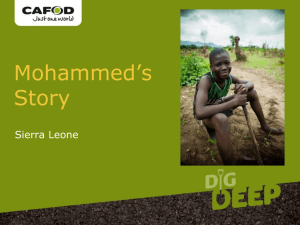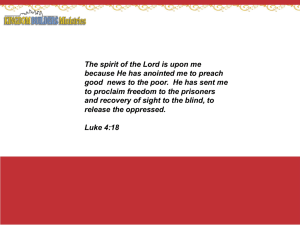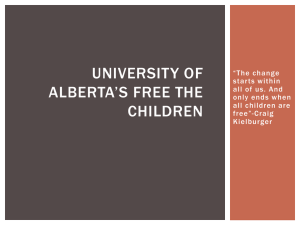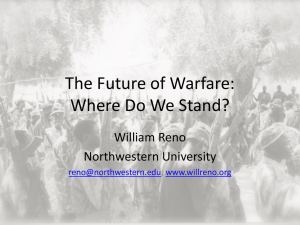Krio Language, Acquisition and Identity
advertisement
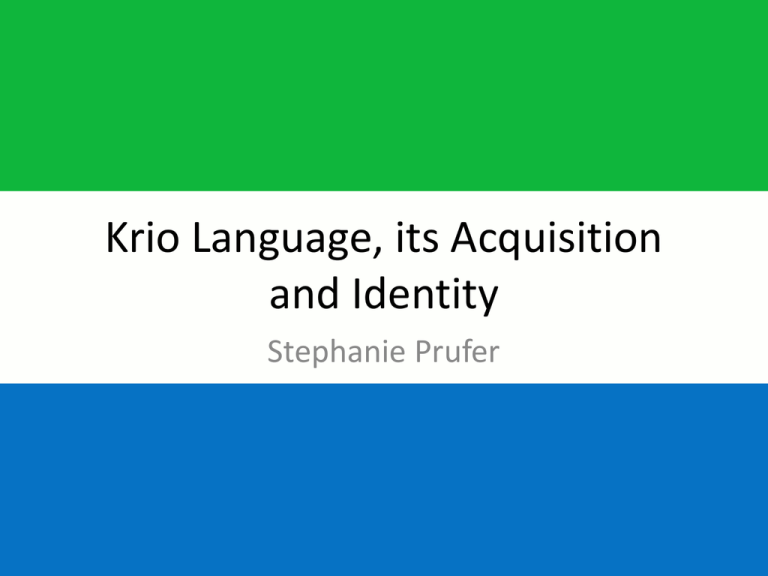
Krio Language, its Acquisition and Identity Stephanie Prufer Structure 1) Krio Language – Comprehension, Phonics, Grammar, background information on Krio 2) Krio Language Acquisition – History of Krio, Theories of language acquisition 3) Krio Identity – how language is used to create meaning, debate surrounding Krio as national language, texts evaluated and used Activity Krio Language What can you understand? What’s similar to English? What’s similar to Portuguese? Sentence structure? Verbal Similarities Written Similarities Krio: Den, Fohx stat foh tohk. I sey to insef, i sey, "Dis Kro ya na uman, enti? If a kin pasweyd am foh tohk; i get foh opin in moht, enti? En if i opin in moht, enti di mit go fohdohm?” Fohx kohl di Kro: "Mohnin titi, " i sey. A so gladi you tif da mit frohm di weytman, bikohs i bin foh trowey am to di dohg... I meyk a vex foh si man du tin leke dat.”Kro nohba opin in tit! Ohl di tem Fohx dey tohlx, Kro moht set tait pan di mit, en in yeys kak foh lisin. English: Then, Fox started to talk. He said to himself, he said, "This here Crow is a woman, not so? If I can persuade her to talk, she has to open her mouth, not so? And if she opens her mouth, isn't it true the meat will drop out?" Fox called to the Crow: "Morning girl," he said. "I am so glad you stole that meat from the white man, because he would have thrown it away to the dog... It makes me vexed to see a man do such a thing as that." Crow never cracked open her teeth! All the time Fox was talking, Crow's mouth was shut tight on the meat, and her ears were cocked to listen. Grammar • Lack inflectional markers such as –s, -ed, and –ing • “to be” as a linking verb • Verb serialization – “i bai klos gi im pikin” He buy clothes give his child • Thematic Sentences (That fat woman who lives over there, she is ugly) • Tonality changes meaning • Imagery Phrases and Words Most important words: • • • • • • • • • • • Boy = bɔ y Child = pikin Girl = titi Food = it Friend = padi Happy = gladi Hello =kushɛ/kabɔ Man= man Please = duya Walk = waka Woman = uman Most important phrases: •Be careful = tek tɛm •Excuse me= kɔmɔt na rod •I am sorry = a beg pardon •I know = I sabi •I’ll be back= a de kam Krio Overview •Lingua Franca – 95% •16 century development •African words and grammar are significant in Krio – 20 different African languages used in Krio •Common View: Influx of slaves in 1800s into Sierra Leone were in Freetown (60,000 former slaves) – need to communicate with British settlers •Oral Tradition – Proverbs spoken •Krio known by 95% of population (Even though Temne and Mende are the large indigenous languages) •Freetown •Originally developed as contact language among emancipated slaves Influences Portuguese Krio = crioulo Kitul (bucket) = quintal Pikin (child) = pequenino Savo, sabi (know) = Saber - Developed during slave trade (Portuguese settlers and explorers need to communicate with community) English - Developed with need to communicate with the British or in the Americas during slavery (debate as to when Krio developed) African “African words and grammar are significant in Krio. During Freetown’s early years, the developing language was influenced by the return of several different groups of West Africans. From 1787 to 1800, poor blacks from London, former U.S. slaves from Nova Scotia, and Maroons from Jamaica came to settle. Beginning in 1806, when the British parliament outlawed slave trade, and until 1860, there was an influx of about 60,000 former slaves who had originally come from West Africa. By 1850, it was estimated that there were as many as 200 African languages spoken in Freetown” (Peace Corps) -Grammar influenced -Krio uses words from 20 different African language 3 Theories – Development of Krio 1) Americo Caribean Origin Theory: – Americas as a result of Atlantic Salve Trade and transplanted to Freetown after end of slavery (Was a pidgin first in the Americas) 2) Domestic Pre-Settlement Theory: – English-based pidgin in African coast before colonies. Contact language developed into Krio, later reimported 3) Domestic Post-Settlement Theory: – Krio developed after the settlement in end 18th century • Similar to the Continuum of Creole (McWhorters) • Superstratist School – Society of Habilitation vs. dilution process (McWhorters) • Language Bioprogram Hypothesis (Bickerton’s Theory in McWhorter’s Work) Language Bioprogram Hypothesis Source: Pidgins and Creoles as Models of Language Change: The State of the Art by John H. McWhorters “Slave children had regularly resorted to their innate linguistic endowment in relating creoles, and that creoles thus provided a window on the core of human language, obscured in ‘regular’ languages by millennia of historical and cultural accertions” (202) Children are the ones who bring about the language acquisition from a pidgin to a creole Value: -To some extent, McWhorters evaluates this hypothesis Limitation: -Not Derek Bickerton’s direct words. May be framed -Resemblance may be accidental -Linguists have provided evidence against “Literacy is a powerful symbol of indigenous identity; it valorizes the community and publicly demonstrates the ways in which it is using its language in active and creative ways (Jenkins 60) Arguments- Sierre Leone English National Language: 1)Ex-Colonial Language – Educational Elite 2) Globalization 3) Retrieve heritage language Arguments- Sierre Leone Krio National Language: 1) Only 10% of population is proficient in English – Elite 2) 95% of population speaks Krio – Vertical integration essential for national identity 3) Krio is already multi-ethnic and nationalistic because it’s able to adapt 4) Versatility as a language (can be used in formal and informal settings) 5) Culture not interchangeable (Thomas Decker) vs. Ex-Colonial Language “Considering the possibility of English being used to potentially [fulfill] such a role, in Africa in general, there is a common view (which many would call a misconception) that national integration can be achieved through the use of ex-colonial languages such as English, French, and Portuguese to facilitate inter-ethnic communication. In the case of Sierra Leone, English has become entrenched as the only official language of the country and the primary index of higher education. However, many would argue that real integration can never be achieved in this manner.” (Oyètádé) Author not advocating for English as the national language Evaluation of the Source Title: ‘Sierra Leone: Krio and the Quest for National Integration’ pages 122-140. Authors: Oyètádé, B. Akíntúndé and Fashole-Luke, Victor • Scholarly article • Presents different points of view • Doesn’t directly state its point of view, but it can be seen through the language used • Points out that national integration is key, and language is a factor in that (chosen to evaluate for this reason) Widespread Nature “Today Krio is not just a language of the Krio population of Freetown, who have frequently disparaged and rejected it, but a language of the whole country, spoken with enthusiasm by people in all parts of Sierra Leone. It is furthermore a language which most non-Krio Sierra Leoneans have come in contact with almost simultaneously with their mother tongue” (Oyètádé) Author advocating for Krio as the national language English and Heritage “Contemporary Native writers such as Ortiz, Momaday, Tapahonso, and other demonstrate that indigenous traditions can be represented in English”(Jenkins 59) Bibliography Oyètádé, B. Akíntúndé and Fashole-Luke, Victor (2008) 'Sierra Leone: Krio and the Quest for National Integration.' In: Simpson, Andrew, (ed.), Language and National Identity in Africa. Oxford: Oxford University Press, pp 122-140. John H. McWhorter (2003). 12. PIDGINS AND CREOLES AS MODELS OF LANGUAGE CHANGE: THE STATE OF THE ART. Annual Review of Applied Linguistics, 23, pp 202-212. Siegel, J. (1997), Pidgin and English in Melanesia: Is There a Continuum?. World Englishes, 16: 185–204. Reading and Writing Krio: Proceedings of a Workshop Held at the Institute of Public Administration and Management, University of Sierra Leone, Freetown, 29-31 January, 1990 Jenkins, Jennifer. World Englishes: A Resource Book for Students. London: Routledge, 2009. Print. "Languages - Krio Words and Phrases." Visit Sierra Leone. Visit Sierra Leone, 2013. Web. 09 Sept. 2013. Peace Corps, Freetown (Sierra Leone). and Peace Corps, Freetown (Sierra Leone). Krio Language Manual. Revised Edition [microform] Distributed by ERIC Clearinghouse [Washington, D.C.] 1985 Fardon, Richard, and Graham Furniss, eds. African Languages, Development and the State. New York: Routledge, 1994. Questia School. Web. 9 Sept. 2013. Shrimpton, Neville. "Thomas Decker and the Death of Boss Coker." Africa: Journal of the International African Institute 57.4 (1987).


